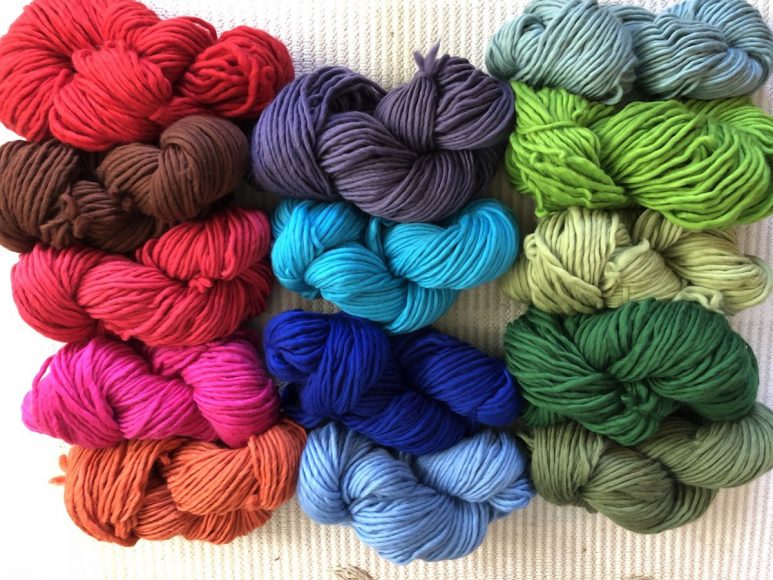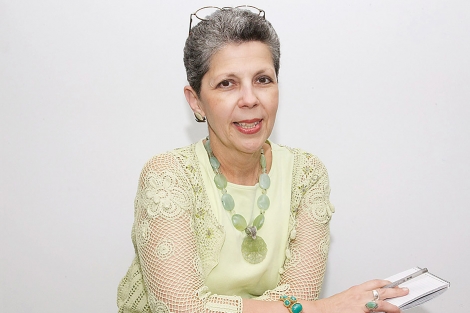“It started after I graduated from college,” says Laurie Kimmelstiel, knitting and weaving supremo, whose love of yarn crafts — if you will forgive the metaphor, in the age of COVID-19 — is downright infectious. “The year was 1975. I didn’t have a job yet and my mother suggested I go to the knitting store that had opened a block away. I already knew how to knit, though not well — I think I learned in Girl Scouts — but suddenly I was smitten.”
Kimmelstiel is a lifelong knitter, author of a best-selling book on knitting (“Exquisite Little Knits: Knitting With Luxurious Specialty Yarns”) and founder of The Ethelridge Road Knitting Salon, now something of a White Plains institution. The first thing she knitted was a cable-knit sweater. “My mother encouraged me a lot and so I continued to knit and soon after, around 1980, I started teaching classes.”
Over the next few years she added weaving to her skill set. “I became a hand-weaver, and that is still a very big component of what I do, my other profession,” she tells me during the course of a phone conversation. “Knitting and weaving are crafts, which both use yarn but in totally different ways.”
She explains that knitting is a muscle memory, like riding a bicycle, so that even if you’ve been taught to knit as a child and don’t pick up the needles again for 30 years, you remember how to do it. “Yes, you may struggle with it initially, but when I start to teach someone who claims to have never knitted before, I can immediately tell whether or not they have. And I’ll say, ‘Did somebody teach you to knit once?’ And they’ll say, ‘Oh yes, but I never got it.’ And I’ll say, ‘Oh yes you did.’ I can see how they hold the yarn or the needles in their hand.”
Kimmelstiel moved from Manhattan to White Plains in 1987 and soon began teaching at the Solomon Shechter School of Westchester, now The Leffell School in Hartsdale, offering a class for parents. She remembers one particular third grade teacher who taught all her students to knit, believing it would help them with their handwriting — “in the days when handwriting still mattered,” she jokes.
I ask Kimmelstiel a how-long-is-a-piece-of-yarn-type question: How long does it take to learn to knit? “I could teach you in five minutes, or less than five minutes” comes the reply. Then she pauses. “No, seriously, in 20 minutes I will have you knitting. I mean, you won’t be an expert, but you’ll be knitting.” And for any kind of proficiency? “Thirty minutes,” she says, and she means it.
The immediate sense of accomplishment and satisfaction that knitting affords you has found its way into her writing — “Exquisite Little Knits” is still available on Amazon and she has written a great deal for the industry — and the Manhattan recovery group BigVision, started by a parent who lost a child to addiction. “We use the craft of knitting as a method for bringing calm and anxiety reduction to young people whose egos are very bruised and are trying to be sober, giving them an outlet for feeling good about themselves. We have two and a half hours and by the time the class ends, everyone leaves there knitting.”
‘Creativity, serenity and craftsmanship’ are the words Kimmelstiel uses on her website to describe the knitting experience. She has recently added a fourth, for the time of the coronavirus — “mindlessness.” Her classes embrace this. “You can just sit and knit, and you don’t even have to look at your work. Knitting is known to reduce your blood pressure and give you a sense of calm that is hard to achieve in the world we live in.” (The tennis star Novak Djokovic has been known to knit during rain delays at the French Open.) People, she says, are looking for ways to be creative, to give themselves comfort when they are feeling anxious. She is inwardly a very anxious person herself, she tells me, “although you wouldn’t know it from the outside.”
The Ethelridge Road Knitting Salon started in 2005 as a group of friends who went walking together. Kimmelstiel would actually knit as she walked. Then the weather got bad and so the group started meeting in her house, and Kimmelstiel began teaching them to knit. And one of her friends said, “Laurie, you can’t keep doing this, we have to pay you.” “And that’s how it began.”
Fifteen years on, the twice-weekly salon, which is currently being held on Zoom, is more popular than ever. People come from all over the tristate area, with classes charged on an individual basis. It’s a casual group but all newcomers have to learn and abide by two simple rules: No discussion of health and no mention of politics. If Kimmelstiel hears either, she nips it in the bud.
She also hosts a knitting retreat every summer at her home in the Berkshires.
Will there be more knitting in the post-COVID world? “There is already,” says Kimmelstiel. “Something I just heard today — a group of women admitting they didn’t mind the quarantine. They are so grateful for the time to sit and knit. And I think we’ll see more and more of it.” Her daughter, meanwhile — the knitwear designer Rebecca Kevelson, who has her own online cashmere yarn company, based in Brooklyn — attests to this, already seeing a huge uptick in yarn sales.
Younger people, Kimmelstiel says, are now also “into” knitting. Then, she corrects herself. “Actually, young people were always into knitting. They’re just not knitting in the closet any longer.” She explains, too, how knitting was looked down on during the rise of feminism. “Women doctors and women scientists, really successful professional women, were among the most prolific knitters. We knew all along that this was something really wonderful to do, but we couldn’t be proud of our knitting as it was perceived negatively. Because — you know — women were supposed to become like men.”
Kimmelstiel goes on to describe how people are drawn to knitters, because when you’re knitting you give off an air of beneficial energy. (Well, not if you’re the ancient Greek Fates, spinning out our length of days, or the murderous Madame DeFarge in Charles Dickens’ “A Tale of Two Cities,” but those are other stories.) Put another way, knitters just seem like nice people, people you can trust. And another interesting phenomenon, she says, is how people are subconsciously drawn to home-knits. “Complete strangers will come up to you and say, ‘That’s a wonderful sweater you’re wearing.’ And it is something which only happens with a home-knit, and you know what? After someone says that to you, it’s a fact that your whole day is positive after that.”
A thought indeed and yet another good reason, as if one were needed, to take up the needles.
For more on Laurie Kimmelstiel’s salon, visit ethelridgeroadknittingsalon.com
And for more on Rebecca Kevelson’s yarns, visit clintonhillcashmere.com





